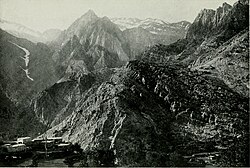수베이족
Subei people江淮民系 | |
|---|---|
| 총인구 | |
| 중국[1] 내 2976만명 이상 | |
| 모집단이 유의한 지역 | |
| 중국(북장쑤, 북양쯔 삼각주, 후이저우, 상하이) | |
| 언어들 | |
| 만다린 중국어(장후이 1차, 표준 2차) | |
| 종교 | |
| 무신론, 불교, 중국 민속 종교, 기독교와 도교 | |
| 관련 민족 | |
| 장후이족, 후이저우족 등 한족 |
수베이족(간체 중국어: 苏北人; 전통 중국어: 蘇北人; 중국어: 江北人; pinyin: Jiangběirén)은 수베이 지역(북장쑤 성)의 장후이 중국어를 사용하는 한족이다.
고향 지역의 자연 재해와 반란으로 청과 공화정 시대에는 우어를 사용하는 장난 지역(양쯔 남쪽)으로, 특히 상하이로 대거 이주했다.[2][citation needed]
수베이 문화는 칭 왕조 중기에는 정교함의 상징으로 여겨졌으나, 중국이 운하시대 대신 철도시대로 진입하면서 위상을 잃었다.[3]
디아스포라 (장베이 외곽)
명나라와 청나라에서는 장후이 화자들이 이주하여 후이 방언 지역으로 정착하였다.[4]
저명인사
참조
- ^ [1], 장쑤성 통계청
- ^ Honig, Emily (Jul 1989). "The Politics of Prejudice: Subei People in Republican-Era Shanghai". Modern China. 15 (3): 243–274.
- ^ Hershatter, Gail. Remapping China: Fissures in Historical Terrain. p. 147–154.
- ^ Hilary Chappell (2004). Hilary Chappell (ed.). Chinese Grammar: Synchronic and Diachronic Perspectives (illustrated, reprint ed.). Oxford University Press. p. 17. ISBN 0-19-927213-1. Retrieved 23 September 2011.
According to Hirata, however, Hui is composed of many layers: its dialects are spoken in an area originally occupied by the Yue i* tribe, suggestive of a possible substrate, later to be overlaid by migrations from Northern China in the Medieval Nanbeichao period and the Tang and Song dynasties. This was followed by the Jiang-Huai Mandarin dialects of the migrants who arrived during the Ming and Qing periods, and more recently by Wu dialects in particular, acquired by peripatetic Hui merchants who have represented an active
추가 읽기
- Emily Honig (1992). Creating Chinese Ethnicity: Subei People in Shanghai, 1850–1980. Yale University Press. ISBN 978-0-300-05105-6.


